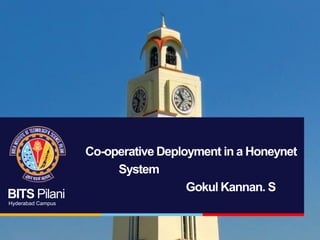Gokul seminar
- 1. BITS Pilani Hyderabad Campus Co-operative Deployment in a Honeynet System Gokul Kannan. S
- 2. Design of Co-operative Deployment in a Distributed Honeynet System Authors: Haifeng Wang, Wingkui Chen Publication: 2010: 14th International Conference on Computer Supported Co-operative Work in Design Objective: To make honeypots easier to deploy & make it more difficult to detect. BITS Pilani, Hyderabad Campus
- 3. Architecture BITS Pilani, Hyderabad Campus
- 4. Multi-Agent System (MAS) âĒ Multiple agent systems âĒ Agent system (Autonomous System) âĒ âĒ âĒ âĒ Term autonomous originates from the Greek term: autos meaning self and nomos meaning rule or law. Enabling systems to operate independently, without external intervention. Intelligent Systems (systems running AI algorithms) Communication, Monitoring, Decision-Making âĒ Goal-based âĒ âĒ Learn & reason towards achieving their goals Same goal BITS Pilani, Hyderabad Campus
- 5. Multi-Agent System (MAS) âĒ 3 types of agents (as per this paper) âĒ Honeypot Agent (H.Ag) â Monitors a set of honeypots â Sends report to D.Ag â Executor of deployment âĒ Host collector Agent (C.Ag) â Collect information about network â Sends report to D.Ag âĒ Deploy Agent (D.Ag) â Get reports from C.Ag and H.Ag â Communicate with other D.Ag (if a best deploy scheme is available) BITS Pilani, Hyderabad Campus
- 6. Honey-Farm System (HFS) âĒ Contains a collection of virtual honeypots âĒ Induce degree â the capacity of inducing attackers âĒ Virtual honeypots can be one of the following âĒ âĒ âĒ Low Interaction High Interaction Medium Interaction BITS Pilani, Hyderabad Campus
- 7. Computer Network System âĒ Contains a set of computer nodes âĒ OS type: Windows (different versions), Linux âĒ Host-alter degree âĒ Host changing rule âĒ IPActive BITS Pilani, Hyderabad Campus
- 8. Challenges in deployment âĒ Type of interaction (low, high, medium) âĒ Honeypot position âĒ âĒ âĒ âĒ âĒ Outside the security system Inside the security system (DMZ) Sub-networks behind firewall Inside the intranet etc. âĒ Distribution of honeypots âĒ âĒ âĒ Nh â no. of honeypots Np â no. of computers P â rate of protection BITS Pilani, Hyderabad Campus
- 9. Co-operative Deploy Strategy BITS Pilani, Hyderabad Campus
- 10. Algorithm 1: Collect status of computer network BITS Pilani, Hyderabad Campus
- 11. Algorithm 2: Collect status of honeyfarm BITS Pilani, Hyderabad Campus
- 12. Algorithm 3: Learning & Final Decision BITS Pilani, Hyderabad Campus
- 13. Algorithm 3: Learning & Final Decision BITS Pilani, Hyderabad Campus
- 14. Algorithm 4: Co-operative Deploy BITS Pilani, Hyderabad Campus
- 15. Experiments BITS Pilani, Hyderabad Campus
- 16. Experiments BITS Pilani, Hyderabad Campus
- 17. Thank You !! BITS Pilani, Hyderabad Campus

















